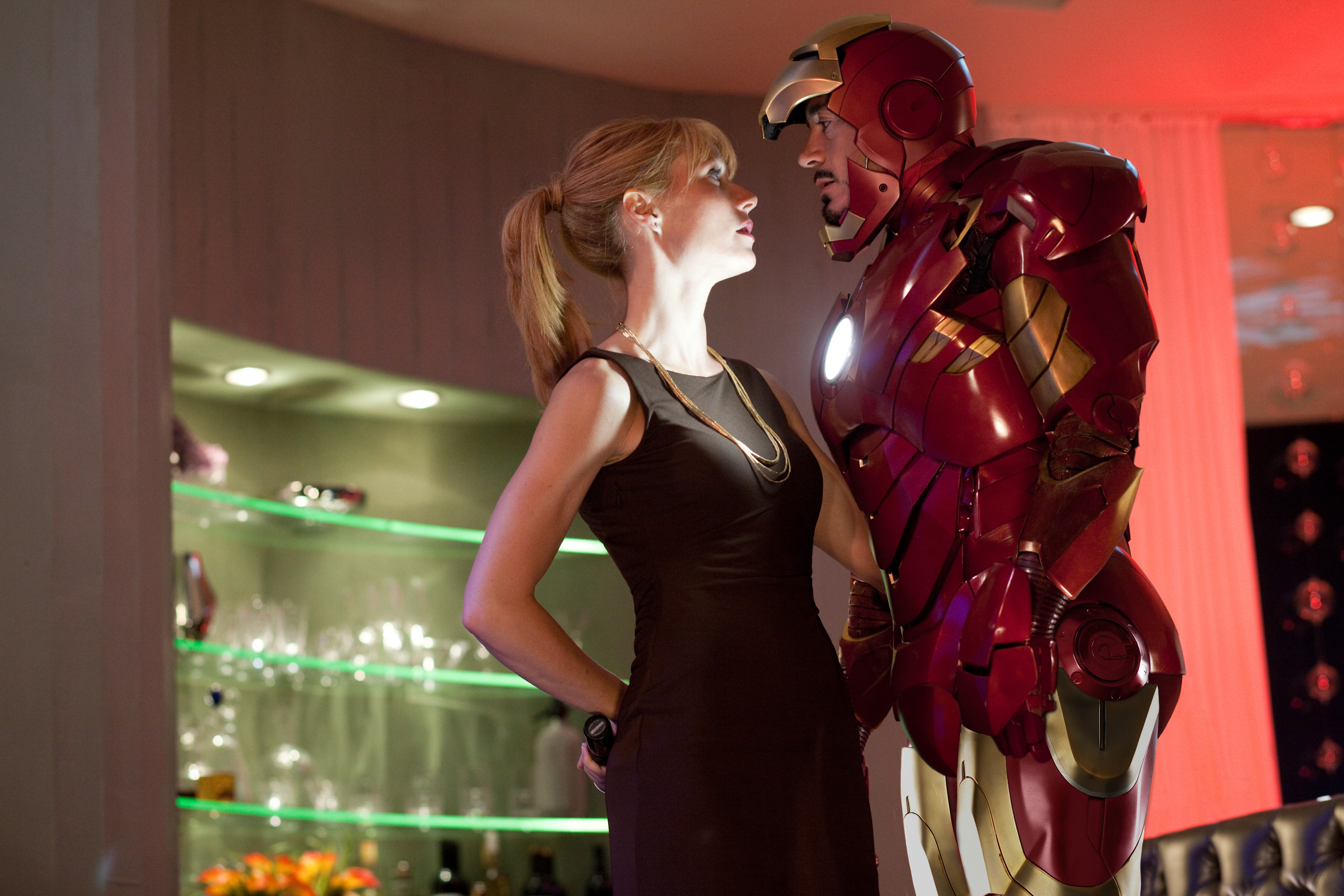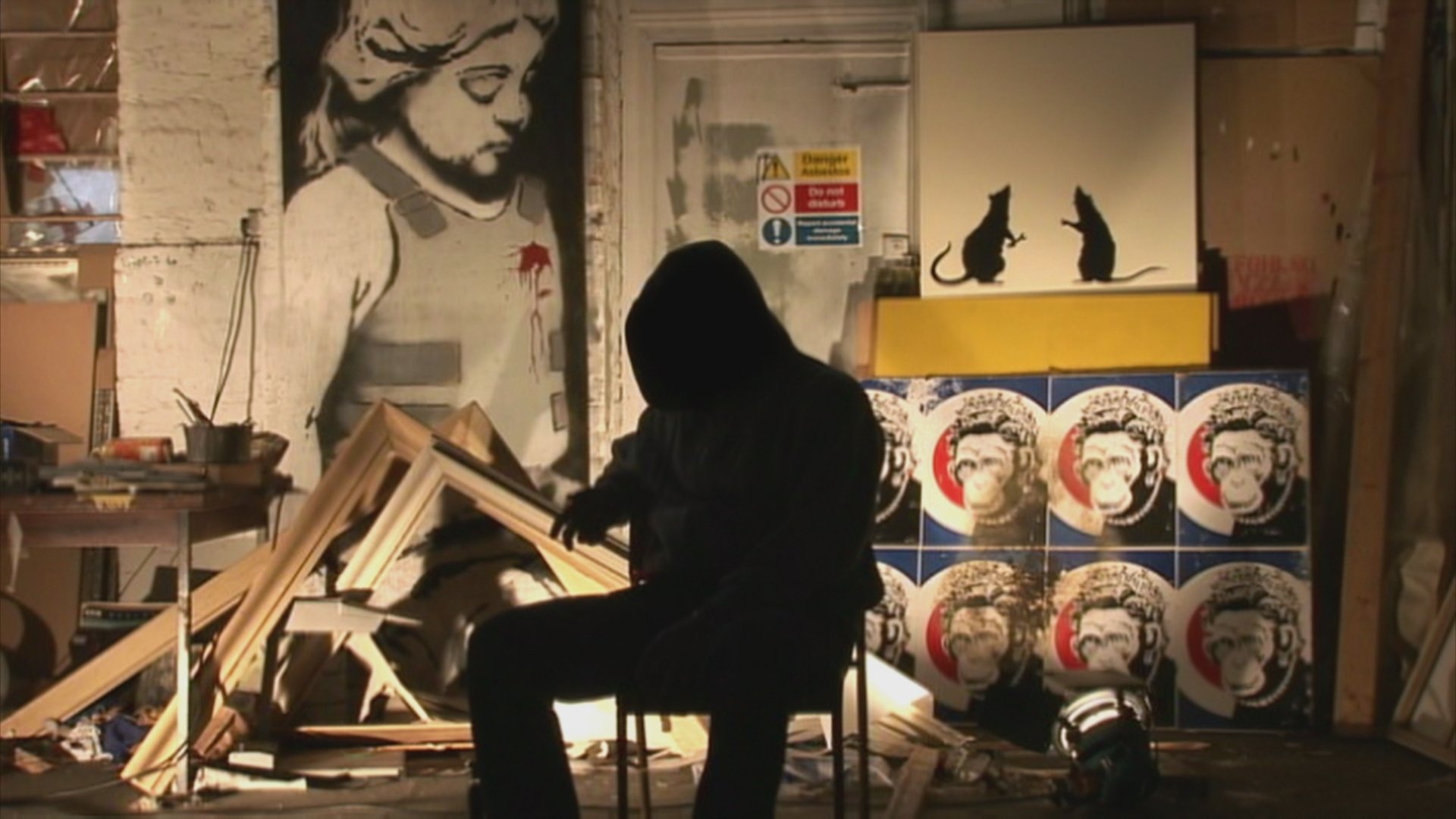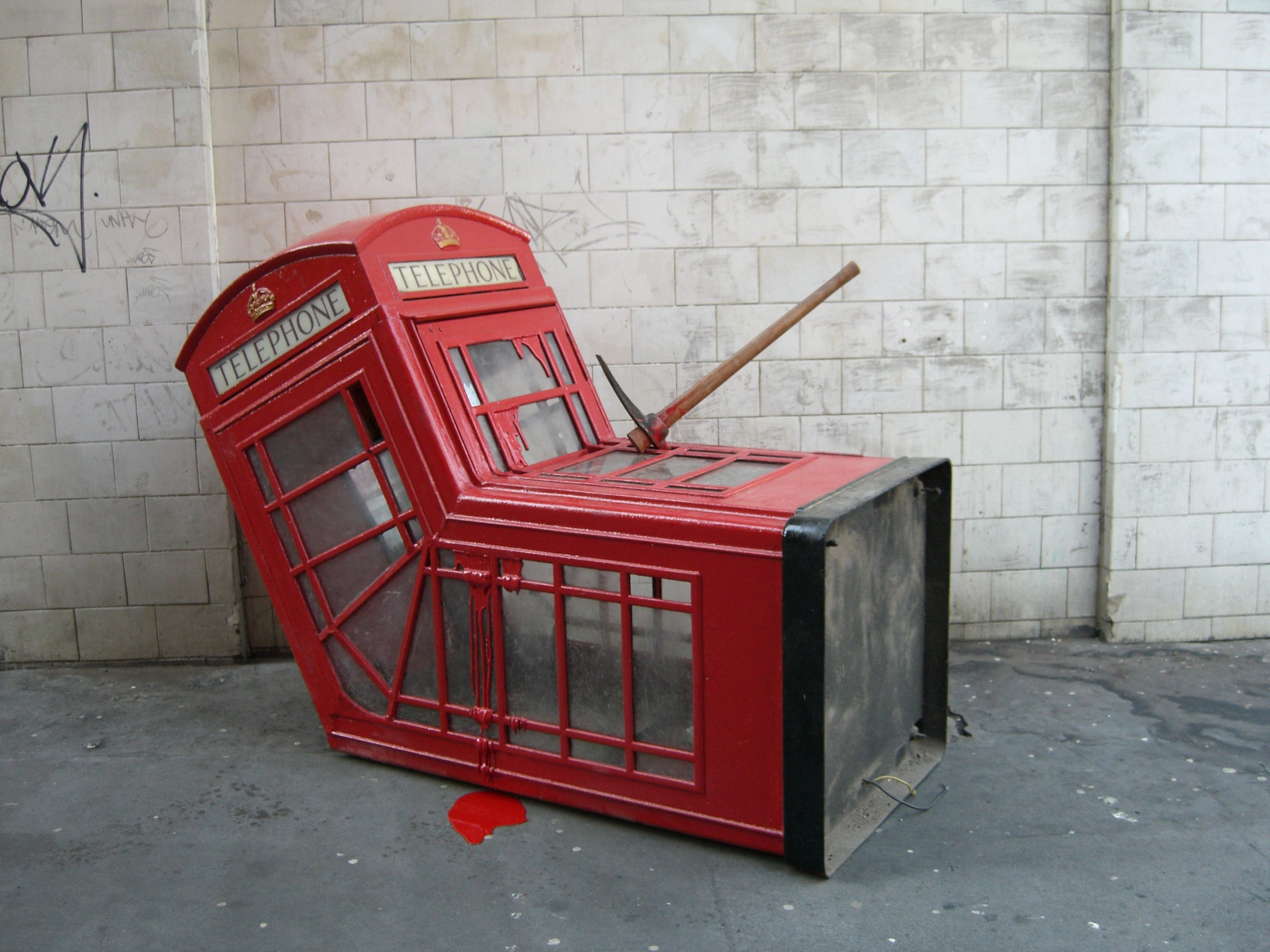Opening Weekend: Iron Man 2, Banksy, Babies and Please Give
Robert Downey Jr.’s rehab is complete—he’s a comic genius shackled to 12-step action movie
Gwyneth Paltrow and Robert Downey Jr. in ‘Iron Man 2’
Share

This weekend at the movies, we’ve got a shooting match of iconoclasts. Take your pick: Robert Downey Jr., Catherine Keener or Banksy. They’re all first-class provocateurs, but each is working on a different scale. As the star in Iron Man 2, Downey Jr. proves that his Hollywood rehab is now more than complete. He proudly sports his shiny new franchise like a post-modern pimp in a cheap suit, even if it did cost US$140 million. And as his nemesis, another iconoclast cashes in his notoriety, Mickey Rourke. Iron Man 2 may well be the summer’s biggest blockbuster, but here’s the catch: there’s something funny about an action movie when the acting is so much better than the action. Going to an action movie for the dialogue is like reading Playboy for the articles. It’s just wrong. For a real-life renegade superhero, check out Banksy, the legendary British graffiti artist who has made his first film without surrendering his secret identity—a marvelous documentary called Exit Through the Gift Shop. Catherine Keener is an iconoclast of a different kind. And she’s in her element in Please Give, Nicole Holofcener’s wry, note-perfect movie about love, deception, greed and self-esteem. There’s no comic book posturing here, just a shrewdly observed drama with a keen wit. It’s a rare gem. And finally, for something completely different, there’s Babies, a lavish documentary about human wildlife that is all babies all the time. This post ends with an update of the Babies review that was first appeared in a BDJ Unscreened blog about Hot Docs, Documentary Tourism.
Iron Man 2
The first Iron Man had the excitement and velocity of a thing being forged from scratch. Not just Iron Man, but Robert Downey Jr.’s comeback. Now it’s just the thing replicating itself, as these things do. Another movie about a man and his gear. A playboy tycoon and his iSuit. It’s the ultimate toy, a wearable computer/weapon/rocket/uniform. We pick up where the last movie left off. Tony Stark announces to the press that yes, he is Iron Man. He makes his entrance as the star of a vulgar trade show at his dad’s old theme park, cavorting with a chorus line of showgirls.. Pretty soon, he’s like a parody of the old Robert Downey Jr. on a bender. Outta sight and outta control. Like a drunk at his own wedding. He’s also dying from toxins, from that palladium disc he uses as a heart. (Palladium? Rhymes with Avatar‘s unobtainium. And it’s what ever A-list guy is dying to have—his very own element.) Stark’s arch-enemy is a ghoulish Russian scientist played by Mickey Rourke, who is fashioning his own wearable military hardware. Rourke looks like more of a wrestler than he did in The Wrestler: a greasy, toxic, tattooed by guy with stringy dreads and a sloppy grin full of metal teeth. He seems to be smothering in his own flesh and you can practically smell the sweat coming off him.
There’s some nice character work here. And under the direction of Jon Favreau, who also has a minor role as Stark’s thuggish driver, Happy Hogan, the script is loaded with witty dialogue. But the action is as dumb as the dialogue is smart. It’s like a Transformer orgy, with armies of metal hulks loudly throwing themselves at each other. As a comic book hero, Downey Jr. is more of a comic than a hero. He’s still Chaplin at heart. And his character is a Swiss Army knife of self-parody. When he sees femme fatale Scarlett Johansson smoldering at him for the first time, his response is to tell his wifey girl friday, Pepper (Gwyneth Paltrow): “I want one of those.” Stark is Everyman who ever wanted the bad woman he can’t have, as opposed to the good one he’s already got. Frankly though, Paltrow’s Pepper is so un-peppery—a bland, nagging, ego-maintaining helpmate—that when Stark promotes her to CEO of his empire, you have to wonder why he doesn’t just ditch her for the ultimate fighting sex bomb played by Johansson. But the script avoids all but a tease of a love triangle, leaving her character no place to go, aside from demonstrating a lot of fast-cut kung fu shot with staccato visuals that make it impossible to see what she’s doing.
Scarlett doesn’t talk much. Neither does Rourke as the shifty Russian brute—a monosyllabic id of a man who seems to resent the effort of language. Robert Downey Jr.’s Stark, meanwhile, is pure, hyper-articulate ego. He’s a weapons-grade guitar hero tripping off the reverb of unlimited narcissism. Irony as feedback. No one else onscreen really stands a chance, especially Don Cheadle, whose Tonto character chafes at the sidekick cliche, yet surrenders to it in the end. Despite all the A-list talent, this is Downey’s show. And his casual, kinetic brilliance almost makes up for the lazy plot and the overload of dumb, clanging fight scenes. He’s one of those actors who creates intrigue out of thin air. He’s like a human puzzle constantly trying to solve itself, an actor racing to keep up with his own brain.
If this were not a documentary, but a Hollywood biopic, you could imagine Robert Downey Jr. playing Banksy, this Dark Knight of the art world who went from graffiti outlaw to gallery darling while remaining anonymous. His face hidden by a shadowed hoodie, Banksy “appears” in Exit Through the Gift Shop as the elusive narrator of his own film, which he explains is not his story, but that of a crazy Frenchman named Thierry Guetta who entered his life. A Los Angeles shopkeeper with a wife and two kids, Guetta became obsessed with shooting video of graffiti artists. Like a fan boy chasing autographs, he worked us way up until finally he meets the secretive Banksy, the Scarlet Pimpernel of street art. As Banksy lets him into the Bat Cave and allows him to shoot his outlaw missions, Guetta graduates from  stalker to filmmaker, roadie and accomplice. He accumulates masses of footage. But at a certain point, Banksy realizes that this filmmaker has no interest in actually turning the images into a film. He’s just a compulsive shooter, chasing the paint. What happens next is downright freaky. (As I mentioned in an earlier blog on Hot Docs, documentaries have become so fictional in style, it’s possible for a critic to “give them away”; so if you keep reading, consider this a spoiler warning.) Guetta finally has a stab at mix-mastering footage into a blitz-like experimental film, an acid trip of images that Banksy considers unwatchable. Banksy may be a guerrilla artist, but he’s not about to squander his legacy. So he takes over Guetta’s Tupperware bins full of tapes and makes his own film, while turning Guetta into the subject.
stalker to filmmaker, roadie and accomplice. He accumulates masses of footage. But at a certain point, Banksy realizes that this filmmaker has no interest in actually turning the images into a film. He’s just a compulsive shooter, chasing the paint. What happens next is downright freaky. (As I mentioned in an earlier blog on Hot Docs, documentaries have become so fictional in style, it’s possible for a critic to “give them away”; so if you keep reading, consider this a spoiler warning.) Guetta finally has a stab at mix-mastering footage into a blitz-like experimental film, an acid trip of images that Banksy considers unwatchable. Banksy may be a guerrilla artist, but he’s not about to squander his legacy. So he takes over Guetta’s Tupperware bins full of tapes and makes his own film, while turning Guetta into the subject.
Whether that is true, or just mockumentary subterfuge, is impossible to say. But as Banksy turns the tables on Guetta, Guetta turns the tables on Banksy and anoints himself as a graffiti artist named Brainwash. Not only that, he mortgages his house and mounts a massive pop art show in a warehouse, ripping off pop art’s greatest thief, Andy Warhol, for his ideas. (Giant Campbell’s Soup spray cans are a centrepiece). Whether the art is in any good or not seems beside the point. He churns out of ton of it with a team of hired hands and the gamble pays off. Thousands flock to his exhibit and overnight the French fanboy becomes an art star. Brainwash sells over $1 million of instant art in a couple weeks. A more twisted version of the American Dream you never did see. It makes for a helluva narrative, and a mind-bending look at art as counterfeit. In that sense, Exit Through the Gift Shop is a meta movie: as artist and impresario merge, it’s hard to tell how much of the film itself is a hoax. But even as Banksy morphs from subject to director, the best thing about this documentary is still Banky’s art, which happens to be well-documented. Exit Through the Gift Shop may be a back-handed self-portrait, but it serves as a clear frame for Banky’s ruthless imagination.

Please Give
Inevitably, writer-director Nicole Holofcener gets called a female Woody Allen. And you can see why. As Allen did in his earlier, more mature works, such as Hannah and Her Sisters, Holofcener makes smart, witty movies that split the difference between comedy and drama, and manage to be both character-driven and riddled with astute social commentary. But the comparison is perhaps unfair to Holofcener. Unlike Allen, she doesn’t resort to cheap gags, and her well-observed narratives possess an uncanny naturalism, with none of the facile moral symmetry that marks even Allan’s best work. Curiously, however, Please Give features an actress who got a major break in a Woody Allen film, Rebecca Hall (Vicky Cristina Barcelona). She plays a radiology technician, and the movie opens with a sequence of her conducting mammograms, squeezing breasts into the x-ray contraption. Talk about a scene that will elicit radically different gender responses. For the male viewer, it’s an unprecedented and glimpse into a medical ritual involving breasts, which are flattened like play dough and rendered strangely unerotic. For the female viewer, it brings a flash of universal recognition. In her director’s note, Holofcener says, “Mammograms are like life: potentially tragic but really funny looking. You’re stripped semi-naked, divested of dignity, shivering with cold and filled with dread. It’s ridiculous but very necessary.”
Holofcener has a knack for dramatizing the awkwardness of naked, necessary human behavior. Her story focuses on a married couple, Kate and Alex (Catherine Keener and Oliver Platt), who own a trendy antique store in Manhattan. They specialize in buying furniture from estate sales, often from people who have no idea what their stuff is worth. The ethics of scavenging also hits closer to home: the couple is waiting for their cranky neighbour (Ann Guilbert) to die so they can knock down the adjoining wall and take over her apartment. Kate and Alex aren’t evil. They’re just middle-class New Yorkers trying to stay ahead of the game. And Kate, who’s compulsively charitable, is wracked by guilt. Complications set in as she and Alex get to know their neighbour’s two daughters—the radiologist, who’s nice, and a cosmetician (Amanda Peet), who’s not. Rounding out the ensemble is the couple’s troubled teenage daughter (Sarah Steele), who has her own neuroses around shopping. I don’t want to divulge more plot than that, except to say that it involves betrayal and guilt, and that nothing is resolved as neatly as it is in most films about relationships gone awry.
Holofcener brings a knowing empathy to all her characters, even the cruel cosmetician played by Peet. But she seems to have found a screen surrogate in Keener, who also starred in the director’s Lovely & Amazing and Friends with Money. Keener always gives the impression that she’s harbouring a dangerous, uncontrollable intelligence, not unlike Robert Downey Jr. In this film, she presents a more vulnerable side than usual, but there is still the glint of the provocateur, a sense that at any minute there’s no telling what she might say or do. For an actor, that’s the ultimate super power.
Babies
It’s telling that this movie comes from France, the country that gave us March of the Penguins, Winged Migration and Microcosmos, because Babies is basically a gorgeous wildlife documentary about very young, very cute humans in their natural habitat. The babies are adorable, the photography is seductive, and it all adds up to a crowd-pleaser. Director Thomas Balmès, who finds his unwitting subjects in Namibia, Mongolia, Tokyo and San Francisco, tracks them from birth to their first steps. Stringing together pearl-like moments of real-time wonder, he taps into the most primitive form of family voyeurism—we stare at babies as they try to invent themselves, and master their bodily functions, one embryonic thought at a time. Baby Porn! The narrative logic is pretty straightforward as the filmmaker intercuts scenes of breast-feeding, crying, peeing, crawling, falling, babbling, playing, standing, stumbling, etc. And teasing cats. There are a lot of animals in the movie. In Africa we learn that although a calf may accidentally kick a baby, cattle tend to walk around them. The filmmaker doesn’t need narration to assert his bias. He makes it pretty clear that he thinks the most toxic environment for an infant is not the African mud hut where the kid is surrounded by flies and sticks a dirt-covered bone into his mouth. It’s in San Francisco, where the baby leads a coddled, antiseptic existence of plastic-sheathed strollers and New Age infant yoga classes. Some may find the sentiment contrived and the cuteness cloying. But whatever you think of it, this is something we’ve never seen before: a movie uniquely devoted to babies. There’s a reason people are mesmerized by them in a living room, and the film casts the same spell.

